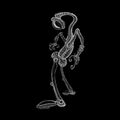Template:Selected anniversaries/October 31: Difference between revisions
Jump to navigation
Jump to search
No edit summary |
No edit summary |
||
| Line 46: | Line 46: | ||
||1965: Jan Kowalewski dies ... Polish cryptologist, intelligence officer, engineer, journalist, military commander, and creator and first head of the Polish Cipher Bureau. He recruited a large staff of cryptologists who broke Soviet military codes and ciphers during the Polish-Soviet War, enabling Poland to weather the war and achieve victory in the 1920 Battle of Warsaw. Pic. | ||1965: Jan Kowalewski dies ... Polish cryptologist, intelligence officer, engineer, journalist, military commander, and creator and first head of the Polish Cipher Bureau. He recruited a large staff of cryptologists who broke Soviet military codes and ciphers during the Polish-Soviet War, enabling Poland to weather the war and achieve victory in the 1920 Battle of Warsaw. Pic. | ||
||1980: Elizebeth Smith Friedman dies ... cryptanalyst and author, and pioneer in U.S. cryptography. She has been called "America's first female cryptanalyst". | ||1980: Elizebeth Smith Friedman dies ... cryptanalyst and author, and pioneer in U.S. cryptography. She has been called "America's first female cryptanalyst". Pic. | ||
||1986: Robert S. Mulliken dies ... physicist and chemist, Nobel Prize laureate | ||1986: Robert S. Mulliken dies ... physicist and chemist, Nobel Prize laureate. | ||
||1987: Raj Chandra Bose dies ... mathematician and statistician best known for his work in design theory, finite geometry and the theory of error-correcting codes in which the class of BCH codes is partly named after him. He also invented the notions of partial geometry, strongly regular graph and started a systematic study of difference sets to construct symmetric block designs. Pic. | ||1987: Raj Chandra Bose dies ... mathematician and statistician best known for his work in design theory, finite geometry and the theory of error-correcting codes in which the class of BCH codes is partly named after him. He also invented the notions of partial geometry, strongly regular graph and started a systematic study of difference sets to construct symmetric block designs. Pic. | ||
| Line 54: | Line 54: | ||
||1988: George Eugene Uhlenbeck dies ... theoretical physicist. | ||1988: George Eugene Uhlenbeck dies ... theoretical physicist. | ||
||1988: Theodor Schneider dies ... mathematician, best known for providing proof of what is now known as the Gelfond–Schneider theorem. Schneider studied from 1929 to 34 in Frankfurt; he solved Hilbert's 7th problem in his PhD thesis, which then came to be known as the Gelfond–Schneider theorem. | ||1988: Theodor Schneider dies ... mathematician, best known for providing proof of what is now known as the Gelfond–Schneider theorem. Schneider studied from 1929 to 34 in Frankfurt; he solved Hilbert's 7th problem in his PhD thesis, which then came to be known as the Gelfond–Schneider theorem. Pic. | ||
||1992: The Vatican admitted erring for over 359 years in formally condemning Galileo Galilei for entertaining scientific truths such as the Earth revolves around the sun it, which the Roman Catholic Church long denounced as anti-scriptural heresy. After 13 years of inquiry, the Pope's commission of historic, scientific and theological scholars brought the pope a "not guilty" finding for Galileo. *TIS In 1822 the church lifted the ban on the works of Galileo and in 1979 Pope John Paul II selected a commission to investigate. On Mar 31 of 1984 the Vatican newspaper, L’Observatore Romano, stated, “The so-called heresy of Galileo does not seem to have any foundation, neither theologically nor under canon law.” It still took until Oct 31, 1992, before Pope John Paul II declared that the church may have been mistaken in condemning Galileo. *Wik | ||1992: The Vatican admitted erring for over 359 years in formally condemning Galileo Galilei for entertaining scientific truths such as the Earth revolves around the sun it, which the Roman Catholic Church long denounced as anti-scriptural heresy. After 13 years of inquiry, the Pope's commission of historic, scientific and theological scholars brought the pope a "not guilty" finding for Galileo. *TIS In 1822 the church lifted the ban on the works of Galileo and in 1979 Pope John Paul II selected a commission to investigate. On Mar 31 of 1984 the Vatican newspaper, L’Observatore Romano, stated, “The so-called heresy of Galileo does not seem to have any foundation, neither theologically nor under canon law.” It still took until Oct 31, 1992, before Pope John Paul II declared that the church may have been mistaken in condemning Galileo. *Wik | ||
Revision as of 14:20, 27 February 2019
1815: Mathematician and academic Karl Weierstrass born. He will be cited as the "father of modern analysis".
1847: Physicist and electrical engineer Galileo Ferraris born. He will be a pioneer of AC power systems, and inventor of the induction motor.
2017: Steganographic analysis of The Eel Escapes Hydrolab reveals fifteen terabytes of encrypted data.
2018: Creature declared Image of the Day by the citizens of New Minneapolis, Canada.




